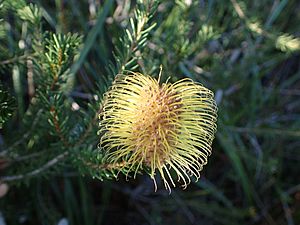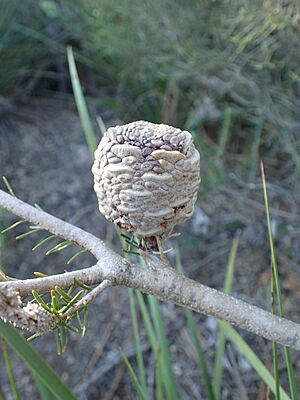Meisner's banksia facts for kids
Quick facts for kids Meisner's banksia |
|
|---|---|
 |
|
| Banksia meisneri flower spike in Helms Arboretum north of Esperance | |
| Scientific classification | |
| Genus: |
Banksia
|
| Species: |
meisneri
|
| Synonyms | |
|
|
Meisner's banksia (scientific name: Banksia meisneri) is a special kind of shrub. It only grows naturally in a small part of Western Australia, in the south-west. This plant has lots of narrow leaves packed together. In winter and spring, it grows spikes of golden-brown flowers. After the flowers, it forms furry fruits. These fruits usually only open up and release their seeds after a bushfire.
Contents
What Meisner's Banksia Looks Like
Meisner's banksia is a shrub that can grow up to about 2 metres (6.5 feet) tall. It usually has one main stem at the bottom, but many branches higher up. These branches are covered with soft, woolly hair.
The leaves are narrow and crowded together. They are about 3 to 7 millimetres (0.1 to 0.3 inches) long and 1 to 1.5 millimetres (0.04 to 0.06 inches) wide. The edges of the leaves are rolled under. When the leaves are new, their top surface is woolly. As they get older, they become smooth. The bottom surface is also woolly, but it's mostly hidden by the rolled edges.
The flowers grow in spikes, mostly on the side branches. These spikes are about 2 to 3 centimetres (0.8 to 1.2 inches) long and 4.5 to 5 centimetres (1.8 to 2 inches) wide. The flowers themselves are golden brown with yellow parts called styles that are curved at the tip. Each flower is about 7 to 9 millimetres (0.3 to 0.4 inches) long and hairy on the outside.
After flowering, the plant forms round or slightly flattened fruit clusters. These clusters are about 3 to 4 centimetres (1.2 to 1.6 inches) long and 4 to 5 centimetres (1.6 to 2 inches) wide. Inside, there are individual seed pods, called follicles, which are small and furry.
Meisner's banksia flowers from April to September. The seed pods usually stay closed until a bushfire happens.
How it Got its Name
The scientific name Banksia meisneri was first officially described in 1845 by a scientist named Johann Georg Christian Lehmann. He published his description in a book called Plantae Preissianae.
The second part of the name, meisneri, was chosen to honour a Swiss botanist named Carl Meissner.
Over time, scientists have studied this plant more closely. In 1981, another scientist named Alex George described two different types, or varieties, of Banksia meisneri. Later, in 1996, he changed these varieties to be called subspecies. These are now known as:
- Banksia meisneri subsp. ascendens
- Banksia meisneri subsp. meisneri
Where Meisner's Banksia Lives
Meisner's banksia grows in a few specific areas in Western Australia. You can find it between the towns of Collie, Pingrup, and Tenterden. It likes to grow in deep sand in areas with low woodlands and shrubs, often in flat, low-lying places.
Life Cycle and Fire
This type of banksia does not have a special underground stem called a lignotuber. This means that when a bushfire burns through its habitat, the plant usually dies. However, the fire is important for its survival! When the plant is killed by fire, its furry seed pods open up. This releases the seeds, allowing new plants to grow and the species to continue.
Is it Endangered?
The Western Australian Government's Department of Parks and Wildlife says that Banksia meisneri as a whole is "not threatened". This means it's not currently at risk of disappearing.
However, one of its subspecies, Banksia meisneri subsp. ascendens, is listed as "Priority Four". This means it is rare or could become threatened in the future, so it needs to be watched carefully.
Growing Meisner's Banksia in Gardens
Meisner's banksia is not very common in gardens or cultivated areas. It grows quite fast and can start flowering from seed after about five years. It prefers a climate similar to the Mediterranean, with dry summers and wet winters. Because of this, it can be tricky to grow in other parts of Australia, especially in the eastern regions.
You can grow this plant from seeds. The seeds usually sprout, or germinate, after about 28 to 39 days.



